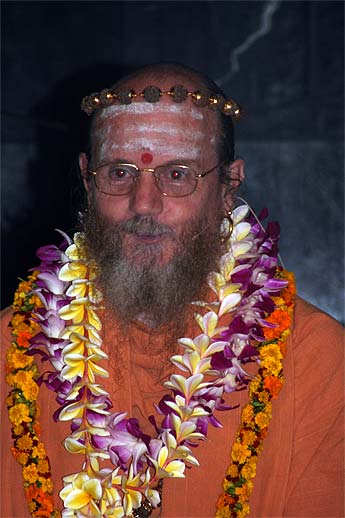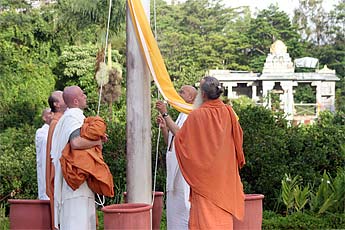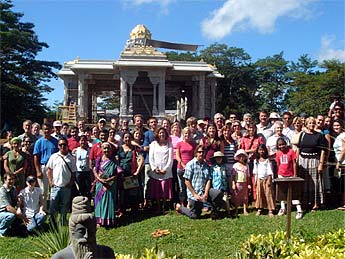Blog Archives
What Happened Today at the Monastery?

Sadhu Paksha is over, Bodhinatha is back from his travels and the Aadheenam was in full swing today with Sun one homa, a change of the flag, new ritau, tour day, and Iraivan worksite busy with preparations for the Nandi Mandapam concrete pour.
Here is Bodhinatha giving his Sun One talk.

It’s early morning in Kadavul. The Tandava poses of Lord Siva’s dance glistening….

Saravananathaswami performs the homa today.








Kulapati Sivakumaren Mardemootoo watches the homa carefully and son Jayendra Manoharan poses for the camera


Bodhinatha was in bright form this morning for his morning talk.


The off we go to change flags and enter the Jivana Ritau. Here are excerpts from the Saiva Dharma Shastras on this season
117 The Second Season: Jivana Ritau
During Jivana Ritau, the rainy season, from mid-August to mid-December, Living with Siva: Hinduism’s Contemporary Culture is the primary text. The key word of this season is work.

Wailua Mission sishya join us…
“The Aadheenam’s 50-foot flag pole flies the rust-colored dhvaja, symbolizing environmental care. Copper-maroon and all shades of red adorn our smaller flags. This is the season of honoring and showing appreciation for those in the vanaprastha ashrama, life’s elder advisor stage. The focus is on preserving what has been created, manifesting goals and fulfilling plans made in the past. Inwardly the emphasis is on direct cognition and caring for the practical details of the external world. Practicality is a word much used this season”

“In the monasteries and the missions, there is a big push on studying the sutras of Living with Siva and these Saiva Dharma Shastras. The format of the mission satsanga changes into one that in fact helps everyone live and breathe with Lord Siva through personal adjustment to the aphorisms of Living with Siva, which define tradition, culture and protocol. Gurukulams are established or renewed to teach the 64 kalas for boys and girls. All work hard to perfect and strengthen Saivite culture in the life of each member. ”

“Kulamatas, grihinis and their daughters should think ahead and make plans to send talented children to dancing, singing and art schools for special courses, and ponder ways to make this possible through scholarships and special funds.”


“It is a time of building and repairing and caring for what has been built, planted or created in any realm of life. It is a physical time, of exercise and exertion in the Bhuloka, a magnetic time for action and willpower, of finishing all jobs started since the first ritau. On the farm, there is harvesting of the land’s fruits as we celebrate abundance. In the missions during Jivana Ritau, the shishyas can form tirukuttams, and thereby visit students’ homes, see how they live and meet their families.”

400 Jivana Ritau Bhajana Satsanga
Jivana Satsanga is from mid-August to mid-December. This is the season when those in the vanaprastha ashrama are especially honored. All turn their attention to the special gifts of knowledge and experience that are the legacy of our elders in the community. We listen to their vision, their high-minded work in the broader community in guiding the dharma within the broader social and spiritual and political arenas. We encourage garlands to be brought to these satsangas, then offered with words of kindness and respect to those who have been through so much and who now have an awakening wisdom by which all within the Church can be guided along the right path by those among us who have grown naturally into the subtle duties of vanaprastha dharma.
1. Activities begin with Ganesha arati by the padipalar of the day. He then leads the group in chanting the Gurudeva Namaskara Veda Mantra.
2. Then the padipalar conducts satguru padapuja.
3. Sutra Meditation: The teaching period for this four-month season emphasizes Living with Siva: Hinduism’s Contemporary Culture. This is the time when we ignite the fire of progress among this holy band. The goal is to strengthen each member’s commitment to upholding all the vowed sutras for the coming year in public and private life and all sadhanas they have been given to perform. Therefore, a thirty-minute meditation is held, guided by the pechalar, on the meaning of vrata and the need for prayashchitta or penance when a vrata is not upheld. The sutras should all be in front of each devotee in written or printed form. During the meditative, reflective period, each one writes down on paper any sutras or neglected sadhanas they need to strengthen their commitment to fulfill. A positive plan for perfection is made, first through inner commitment and then actual change. These papers are kept by the devotee and looked at each night before sleep. They are finally burned in a full-moon havana when all penances have been completed and guilt has disappeared. This tantra demonstrates that each one is responsible to himself for applied metaphysical practices and consciously recuperating sadhanas that were neglected along life’s pathway. This is the Natha way of self effort to attain Self Realization.



Dawn breaks over the Wailua River valley below.


Iraivan looks lovely in the morning after some light showers. The place is humming now as contractors arrive for the day’s work on the foundation of the Nandi Mandapam

The ground and gravel bed were laid in of the past few days and compacted and now it is time to put up the forms for the cement.




All around are stones awaiting their time to become part of the amazing Iraivan temple.

The silpis at work, making refinements on the edge of the roof.

Today was tour day for this phase.


About 70 people came for the 9 AM tour.

And then 30 more for the 11 AM tour.
From Our Gurus' Teachings
Archives are now available through 2001. Light colored days have no posts. 1998-2001 coming later.
